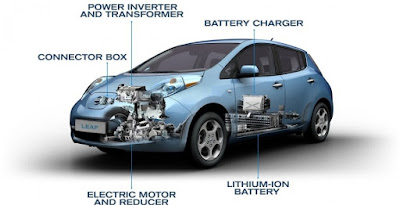Internal combustion engines generate usable torque and power in a narrow band of engine speeds. To accelerate the vehicle, multispeed transmissions step that down, in varying gear ratios, to keep the engine in its power band. Keeping the engine in its power band also proves to be the most efficient and durable. An engine, in first gear, can easily accelerate a car to 30 mph, but would also shake itself to bits attempting to accelerate to highway speed. Likewise, that same engine would hardly be able to accelerate from a stop in 6th gear.So,we require gearbox in case of internal combustion engines because usable torque and power is generated in a narrow band of engine speeds.The variation of torque is very high at different engine speed range.
In case of electric vehicles, electric motor-generators (MG) generate 100% of their torque at very low speeds, DC MGs near stall (zero rpm), and AC MGs around 1,000 rpm, as a general rule. As rpms increase, torque falls off at a fairly linear rate, at the same time that power is increasing. Toyota Prius, for example, the MG generates up to 300 N•m of torque around 1,500 rpm, trailing off to about 50 N•m at 6,000 rpm. At its most-efficient, 93%, the MG is pushing only 100 N•m at 2,250 rpm, perfect for cruising. In any case, a multispeed electric vehicle transmission is unnecessary because even 100 N•m is plenty of torque at cruising speed.Torque is necessary for acceleration, the most of which is generated near stall. Power is necessary for cruising, the most of which is developed at high rpm.
In case of electric vehicles, electric motor-generators (MG) generate 100% of their torque at very low speeds, DC MGs near stall (zero rpm), and AC MGs around 1,000 rpm, as a general rule. As rpms increase, torque falls off at a fairly linear rate, at the same time that power is increasing. Toyota Prius, for example, the MG generates up to 300 N•m of torque around 1,500 rpm, trailing off to about 50 N•m at 6,000 rpm. At its most-efficient, 93%, the MG is pushing only 100 N•m at 2,250 rpm, perfect for cruising. In any case, a multispeed electric vehicle transmission is unnecessary because even 100 N•m is plenty of torque at cruising speed.Torque is necessary for acceleration, the most of which is generated near stall. Power is necessary for cruising, the most of which is developed at high rpm.
At lower speeds we need high torque which electric motor generates but in case of engines it is not so.This is shown in the graph above.The curve is almost linear in case of electric vehicle which shows that torque is almost same for wide range of operation.



No comments:
Post a Comment